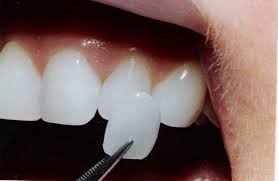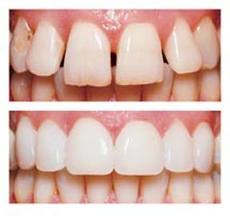Veneers
Porcelain veneers are ultra-thin shells of ceramic material, which are bonded to the front of teeth. This procedure requires little or no anaesthesia, and can be the ideal choice for improving the appearance of the front teeth. Porcelain veneers are placed to mask discolorations, to brighten teeth and to improve a smile. more about veneers.


What is the process of the treatment?
Trimming:
The enamel on the front side of the tooth is trimmed back. Usually the dentist's goal is to trim the tooth about the same amount as the thickness of the veneer that will ultimately be bonded in position. This way the overall size of the tooth will not be dramatically changed.Impression:
Once the proper amount of enamel has been trimmed, your dentist will need to make a copy of your tooth. It will be from this copy that your porcelain veneer will be fabricated.Temporary Veneers:
Your dentist can create a temporary veneer for you to wear during the period while the dental laboratory is creating your porcelain veneer.Bonding:
Once you and your dentist have determined that the shape and shade of your veneer is appropriate it can be bonded in position.First the porcelain veneer will be cleaned and prepared for cementation, or adhesion. Your tooth will also be cleaned, usually by polishing it. The enamel surface of your tooth will be etched with a mild etching gel. This etching, on a microscopic level, roughens the surface of the tooth, just like glass that has been etched has a "frosted" texture. This enamel roughness aids in the cement's ability to form a strong bond with the tooth, and it is a hallmark of dental bonding technique.
Cement will now be placed on the veneer and the veneer will then in turn be placed on your tooth. Your dentist will ensure that the veneer is in its proper place and then cure or set, the cement, usually by shining a special light on it. This light (which is often blue) passes through the translucent veneer to the cement which lies underneath. The light activates a catalyst in the cement, causing it to cure in just a few moments. At this point, the porcelain veneer is securely bonded in position. There will probably be at least a little excess cement present at the edges of the veneer that your dentist will need to trim off and polish down.
You and your dentist will also need to evaluate the veneer's precise contours and trim or reshape them as you feel is best. Your dentist will also spend time evaluating your bite and making sure that the veneer is adjusted appropriately for it.